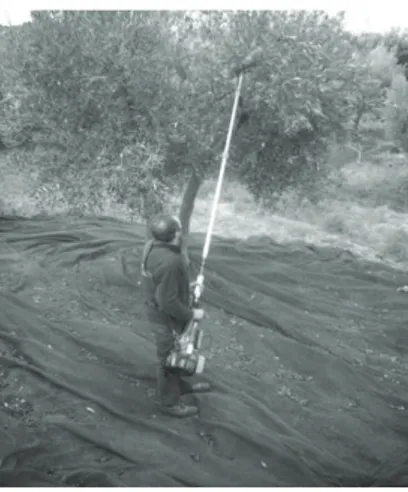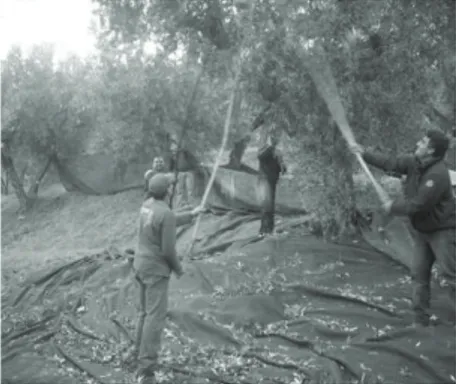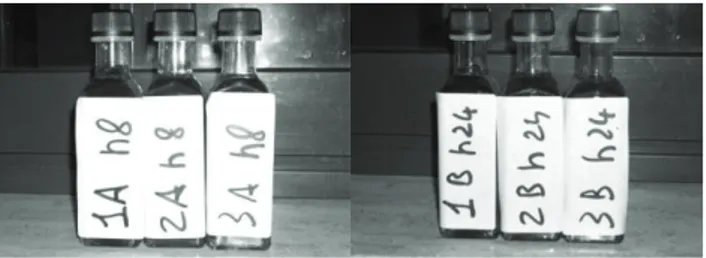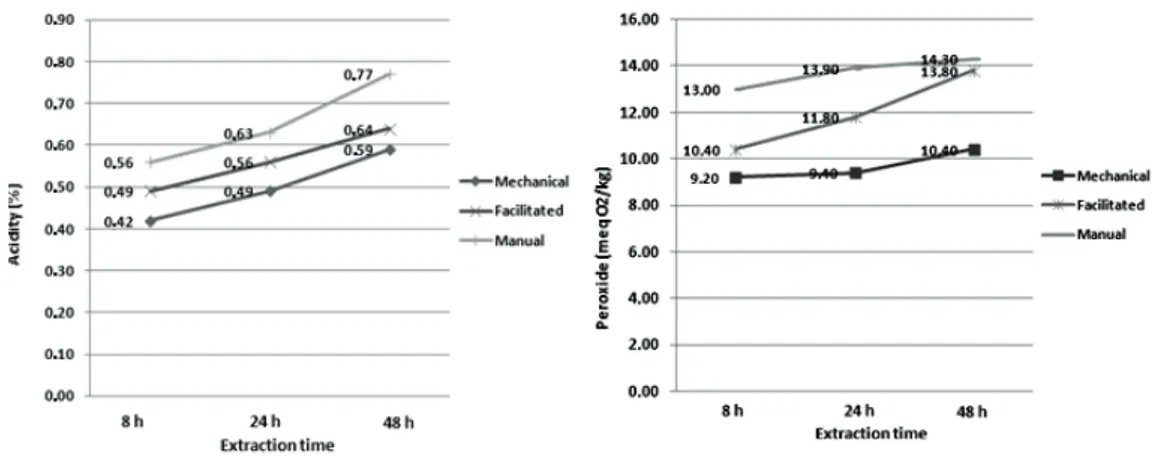Agronomy Research 13(1), 7–16, 2015
Effects of the divers olive harvesting systems on oil quality
L.M. Abenavoli
*and A.R. Proto
Department of AGRARIA, Mediterranean University of Reggio Calabria, Italy; *Correspondence: [email protected]
Abstract. Three olives harvesting systems from the tree have been compared (manual, facilitated
and mechanical) through experimental trials carried out respectively in three plots of a Calabrian olive orchard in the Province of Crotone. The grove is traditional and monovarietal, composed of
Carolea cultivar with a planting density of about 150 plants ha-1. In this study, work productivity
in three divers sites where harvesting was achieved according to different systems has been examined, as well as their effects on produced oil quality. Olives have been harvested by mean of sticks and nets in the manual harvesting (system I), by mechanical aids and nets in the facilitated harvesting (system II), and finally, by mean of trunk shaker and nets in mechanical harvesting (system III).The different work sites have been examined in terms of work productivity, as well as in terms of impact on final product quality, through the withdrawal of a series of oil samples extracted separately and analyzed in laboratory. From the effectuated trials, it has emerged that the site operating with mechanical harvesting has achieved the best results, both from quantitative and qualitative points of view. Indeed, olives harvested mechanically, certainly more intact than those harvested with other systems, produced oil with the best organoleptic parameters.
Key words: olives, mechanical harvesting, oil quality.
INTRODUCTION
With about 3,300,000 tones, Italian production of olives is situated at the second place in the world after Spain, and it is concentrated for almost 80% in three southern regions: Apulia, Calabria and Sicily (FAOSTAT, 2009 & ISTAT, 2002–2008).
The high economical value assumed by such cultivation in the territories where it is spread justifies the numerous researches aimed to solve problems related to the production. The main one is represented by olives harvesting and its economical and management aspects. For example, in traditional groves, the cost of manual harvesting only at times exceeds 60% of the entire production cost (Zimbalatti, 2004). To promote more suitable harvesting systems with use of trunk shakers or other modern machinery, it is necessary therefore, to encourage new intensive plants, able to be fully mechanized, utilizing new trunk shakers that through a correct use improve olive harvesting and subsequently oil quality.
Currently in Calabria mechanical harvesting is quite diffused, especially in some areas. Indeed, date the exceptional rusticity of the plant, the orographic conditions of the area where traditionally it has developed the olive (with the exception of the ‘Piana di GioiaTauro’) are characterized by sloping or very slope lands, and frequently
to the size of the trees, other forms of mechanization: the rods shakers portable and/or the mechanical pick up from ground. (Abenavoli & Marcianò, 2013)
Despite the persistence of the economic crisis, there is a consolidated part of consumers that prefers to acquire high quality oil. This purchase tendency would certainly be reinforced in the future if accompanied by lower prices, therefore lower production costs. This is possible only through a larger spread of modern machinery such as trunk shakers that preserve furthermore product quality. (Giametta & Pipitone, 2004) In this context, Mechanics Section of the Department of Agriculture of Reggio Calabria carried out a number of harvesting trials in a Calabrian olive farm situated in the Province of Crotone. In this study, work productivity in three divers sites where harvesting was achieved according to different systems has been examined, as well as their effects on produced oil quality.
MATERIALS AND METHODS
The research was conducted in the harvesting period during the years 2012 and 2013. In particular, the harvesting tests were performed during the last week of November in which were analyzed three different systems of harvesting of olives and for each yard was picked an oil sample for analysis in a specific laboratory analysis to determine the quality organoleptic properties.
The olive farm, subject of this study, is located in the Calabria territory of Cotronei at 500 meters above sea level, in the province of Crotone (in Alto Marchesato), and in addition to having a surface with about 200 ha of olive trees, has its own oil mill for the processing of olives.
Based on the data collected for half a century in ‘Hydrological Yearbooks of the Hydrographic Service of the State’ and made available by ARPACAL on its website (ARPACAL, 2009), is apparent that the station weather-hydrological of Cotronei is interested by average annual rainfall including between 800 and 1,200 mm, distributed on average on 73 rainy days. In particular in the 2011 (1,746 mm) and in the 2012 (1,647 mm) there has been an increase of mean annual precipitation, distributed an average of about 100 rainy days per year. The average annual temperatures vary between 16 °C and 18 °C, with absolute minimum temperatures that does not descend below zero and those maxims that reach the 42 °C.
By virtue of this brief analysis, for the station of Cotronei, can be attributed the climate to the type Mediterranean, with a period of aridity variable from 4 to 5 months (May to September) and precipitation of stormy character generally confined to the autumn and winter.
In the corresponding olive campaign, the total production of olives in the farm concerned by the trials was equivalent to 1,300,000 kg, with about 240,000 kg of extra-virgin oil obtained with an average yield of 18.46%.
The farm, the subject of this work, consists of a traditional monovarietal grove of Carolea cv, and is composed of three plots (indicated in the following as: a, b and c), not homogeneous in ground topography and planting distance. In each of these plots, it has been adopted a harvesting system retained more suitable for the specific features (Table 1 and 2).
Table 1. Studied plots with respective ground topography and utilized harvesting system
Plot Ground topography Harvesting system
a plane mechanical
b declivous facilitated
c high slope manual
Table 2. The three harvesting organizations
Workers for
activities Plot ‘a’ Plot ‘b’ Plot ‘c’
Mechanical shaker 1 0 0
Vibrating rod 0 2 0
Wood sticks 0 2 3
Harvesting nets 8 4 2
Moving boxes 2 2 2
The three harvesting organizations utilized in the three plots are described in the following:
Mechanical harvesting in plot ‘a’ (plane ground):
The site of the first trial is made up of a level ground and the olive trees are the cultivar Carolea with groves are planted of 10 x 10 m and an average age of about 100 years (Fig. 1). The trees are grown vase-shaped and have a framework composed of three or four main branches. The latter have the characteristic trend assurgent (typical of this cultivar) while the height of the trunk average of 1–1.20 m. Accordingly, the trees are even considering the heavy weight (3÷5 g) of the fruit, particularly suitable for mechanical harvesting with the employment of the trunk shaker.
The harvest was performed using self-propelled vibratory shaker (SICMA F3) wheel drive on three wheels(the singleis posterior and steering axle) hydraulic transmission. The warhead-carrying arm is telescopic and the commands for the handling of machine and the vibrations are carried out by a joystick; the vibrating head is at very high frequencies and self-braking. The engine is a supercharged 4-cylinder IVECO that packs a punch of 93 kW at 2,300 g min-motor-1 (Fig. 2).
The collection began with the drawing up of the networks under the foliage of the olive trees and along the between rows and after the shaker proceeded along the line directing the head of the vibrator to the trunk of each tree (usually about 10 cm below the point of insertion of the main branches). In the meantime in which the machine shaking trees already provided with networks, some workers continue to drawing up the other networks under the olive trees yet to shake, in order to ensure a certain continuity of the work, while the fallen olives in networks were unloaded into the cassettes by other workers. The free networks were then dragged under the following trees, while the olives, after clearing them from leaves and twigs, were initiated at the oil mill.
The main critical issues were reported by this phase mainly concerned the difficulties of combining the action of the shaker with the movement of networks by the workers for the burden of managing them (due to the weight and size), plus some downtime of the vibrator during the maneuvers of approach and departure from the trunk of the trees.
Facilitated harvesting in plot ‘b’ (declivous ground):
The site of the second test he was in a declivous ground, with an average slope at around 22% and the majority of olive trees were arranged in terracing. The trees were of cultivars Carolea, with groves are planted of 10 x 10 m and an average age of about 100 years (Fig. 3). The trees are grown polyconic vase-shaped and had an average height of the trunk of about 1 m. The orographic conditions of the terrain does not have allowed to execute the harvest with the vibrators self-propelled (given the dimensions that have the machines) and so this was made with portable mechanical devices fitted with hooks shakers of boughs.
The machine used is the Cifarelli SC800 which is provided with a motor of 52 cm3, single-cylinder two-stroke air-cooled. The rod is of the telescopic type with variable length (from 3 to 5 cm), and is provided with terminal hook. The whole device weighs about 15 kg and can produce more than 2,000 oscillations min-1 (Fig. 4).
In this second yard after you have spread networks manually under the trees, two workers with facilitators devices were starting to shake up the single fruit bearing boughs of each tree. The operations of shaking are completed with the manual down hearting by two workers fitted with wooden rods for dropping the remaining drupes. Finally, the fallen olives were being transferred from the nets in crates and after clearing them from leaves and twigs, promptly sent to the oil mill.
During the tests of harvest were observed some dead times determined both by fatigue of workers in the use of the shaking portable because of the vibrations transmitted in the arms, and the difficulties encountered in networks drafting along the rows because of the slope of the ground and of the irregular terracing.
Manual harvesting in plot ‘c’ (ground with high slope):
In the third test site the ground was strongly declivous, with an average gradient of 32% and the majority of the plants were disposed in terraces. The trees were reared free-form and they had an average height of the trunk of about 1.00 m (Fig. 5). In this case the orographic conditions of the ground and the difficulty of displacement of workers had not allowed to perform the harvest with no mechanical device also of portable type. Harvesting was therefore carried out only manually utilizing the wooden poles (Fig. 6).
Figure 5.
Ground
with a high slope (plot ‘c’). Figure 6. Manual harvesting (beating).In this yard, once the networks were drawn under the foliage of the olive trees, three workers equipped with wooden poles started to beat the fruiting boughs. The olives have fallen into the nets were collected in crates and, after clearing them from leaves and twigs, sent directly to the oil mill.
The high slope of the ground and the irregular terracing, made it difficult the working conditions especially in the movements of the workers when they spread forth their nets along the rows. The olives for more were falling away from them for the action rather vigorous of the wooden poles on fruiting boughs.
After having examined productivity in the three different work sites, the study focused on the characterization of oil quality influenced by harvesting system. Indeed, olives harvesting techniques and delivery time to the extraction unit may affect organoleptic properties of the transformed product. Therefore, olive oil samples have been extracted for each harvesting systems adopted according to the following
· 3 samples of olive oil pressed after 8 hours from harvesting, identified with the letter ‘A’.
· 3 samples of olive oil pressed after 24 hours from harvesting, identified with the letter ‘B’.
· 3 samples of olive oil pressed after 48 hours from harvesting, identified with the letter ‘C’.
Figure 7. Some of the oil samples used for the analysis.
Each oil sample of 250 ml has been labelled according to the corresponding harvesting system and extraction time (Fig. 7) and it has been sent to an appropriated laboratory to be analyzed. The laboratory analyses are aimed at determine acidity percentage and peroxide quantity present in each sample of oil. Acidity represents a fundamental indicator for olive oil quality because it defines commodity classification. Peroxide quantity; however, indicate oxidation level of unsaturated fatty acids that provide a characteristic rancid smell to the oil, especially, if it is subject to high temperatures, light and oxygen. Less is the number of peroxide, better is olive oil quality and its shelf-life. The oxidative processes may be revealed through measurement of spectrophotometric constants:
· K232 (value of specific extinction at 232 nm, the wavelength corresponding to the maximum absorption of conjugated dienes);
· K270 (value of specific extinction 270 nm, the wavelength corresponding to the maximum absorption of conjugated trienes).
· DK (trend of the absorption curve in the range of 264–272 nm; sheds light on the presence of the compounds of secondary oxidation).
RESULTS AND DISCUSSION
Work analysis in the three harvest sites has shown that plot ‘a’ (mechanical harvesting) has a higher yield, with a work capacity equal to 80 plants a day (during an 8 hours working day. Plot ‘b’ (facilitated harvesting) has instead presented a work capacity of 36 plants a day with about 4,000 kg day-1 of harvested olives. Such capacity resulted two times higher than in plot ‘c’ (manual harvest) that reached a productivity of 2,000 kg day-1.
Finally, elaborated data show how the use of mechanical aids and shaker machines during harvesting guarantees an important increasing of productivity, compared to the site where harvesting was effectuated manually (Table 3) (Giametta & Zimbalatti, 1997).
Table 3. Summarized scheme of obtained yields with the three harvesting systems
Harvesting
system Utilized machine Lab./ site
Site capacity Work productivity Variation with manual harvest (%)
Plant day-1 kg day-1 plant ay-lab.-1 kg day-lab.-1
Mechanical
(Plot ‘a’) shaker Sicma F3 11 80 7,000 7.3 636 143
Facilitated (Plot ‘b’) mechanical aids Cifarelli 10 36 4,000 3.6 400 20 Manual (Plot ‘c’) – 7 20 2,000 3.0 300 0
Moreover, there is another aspect to consider that concerns damages undergone by olives with the employment of divers harvesting systems. Particularly, olives from plot ‘a’, obtained by mechanical harvesting, are visibly intact; however, olives obtained by mean of facilitated harvesting appear partially damaged because of beating. Thus, in order to avoid that oxidative and fermentative processes affect qualitative features of oil, a fast transport to the extraction unit is necessary for an immediate transformation. Effectuated analyses in a renowned regional laboratory demonstrated that samples have different characteristics between them, although, they fulfil all requirements of UE Regulation about extra virgin olive oil quality.Acidity, peroxide number and UV spectrophotometric (K232, K270 and Delta-K) are parameters determined in the laboratory. The measure of acidity is the oldest parameter used to assess the quality of olive oil and its product classification. As it can be noted in Table 4, obtained oil from olives harvested mechanically, has the best parameters in the three analyzed samples. The following figure (Fig. 8) shows acidity and peroxides tendency in the three extracted samples for each harvesting system.
Table 4. Results of the analyses on olive oil samples (UE Reg. n° 1531/2001)
Sample Harvesting system Acidity (%) Peroxides (meq O2/ kg-1) UE Reg. n° 1531/2001 Acidity (%) Peroxides (meq O2 kg-1) Classification
1 A mechanical 0.42 9.2 < 0.8 < 20 Extra virgin olive oil
2 A facilitated 0.49 10.4 < 0.8 < 20 ‘ 3 A Manual 0.56 13.0 < 0.8 < 20 ‘ 1 B mechanical 0.49 9.4 < 0.8 < 20 ‘ 2 B facilitated 0.56 11.8 < 0.8 < 20 ‘ 3 B Manual 0.63 13.9 < 0.8 < 20 ‘ 1 C mechanical 0.59 10.4 < 0.8 < 20 ‘ 2 C facilitated 0.64 13.8 < 0.8 < 20 ‘ 3 C Manual 0.77 14.3 < 0.8 < 20 ‘
Figure 8.Acidity and peroxides tendency in analyzed samples.
Always according to the forward regulation (UE Reg. n° 1531/2001), the results of UV-spectrophotometric analyses effectuated on the same samples are reported in Table 5. In this case also the analyses complete and confirm the previous results about the best quality of oil obtained from olives harvested mechanically.
Table 5. Results of spectrophotometric analyses on extracted samples
Sample Harvesting system Acidity (%) Peroxides (meq O2 kg-1) UE Reg. n° 1531/2001 Acidity (%) Peroxides (meq O2 kg-1) Classification 1 A Mechanical (plot ‘a’)
0.42 9.2 < 0.8 < 20 Extra virgin olive oil
1 B 0.49 9.4 < 0.8 < 20 ‘ 1 C 0.59 10.4 < 0.8 < 20 ‘ 2 A Facilitated (plot ‘b’) 0.49 10.4 < 0.8 < 20 ‘ 2 B 0.56 11.8 < 0.8 < 20 ‘ 2 C 0.64 13.8 < 0.8 < 20 ‘ 3 A Manual (plot ‘c’) 0.56 13.0 < 0.8 < 20 ‘ 3 B 0.63 13.9 < 0.8 < 20 ‘ 3 C 0.77 14.3 < 0.8 < 20 ‘
The analyzes carried out on the chemical quality of olive oil, have shown that the collection system can influence the composition of olive oil (Giuffrè, 2013; Giuffrè & Louadj, 2013).
CONCLUSIONS
From the effectuated trials, it has emerged that the site operatingwith mechanical harvesting has achieved the best results, both from quantitative and qualitative points of view. Indeed, olives harvested mechanically, certainly more intact than those harvested with other systems, produced oil with the best organoleptic parameters (Giametta & Zimbalatti, 1994).
Despite this, olive harvesting in Calabria is still effectuated almost exclusively with manual systems or facilitated ones, from the tree when possible or worst from the ground. All these problems engender unfortunately a product mostly characterized by a scarce quality. Consequently, Calabria although being the second region in Italy for olive oil production, as well as particularly devoted to such cultivation, occupies the last places for high quality olive oil production (Giametta & Zimbalatti, 1991).
The studied case demonstrates that also in Calabria, as in other Italian region, there are excellent farms which adopt harvesting and extraction techniques that guarantee a product of high quality, obtaining recognition at National and International levels. Such farms found however difficulties to emerge in extra regional markets because of the reputation of the local sector (Zimbalatti et al., 2009).Innovative mechanized harvesting operations represent a real watershed in the process of modernization of world olive growing. The use of mechanized system of harvesting, which responds to issues linked to chronic shortage of labor and to the need to contain production costs, is likely to revamp that portion of obsolete and non-cost-effective practices which are no longer competitive in the olive growing sector.
The Calabrian oliviculture, except sporadic innovative examples, remains substantially related to traditional systems of production characterized by high costs, low unitary productivity, and a low index of mechanization.
For more competitiveness, it is necessary to have in the entire region a further spread of more modern and dynamic orchards, easier to mechanize and therefore more productive. Such innovations would certainly allow to lower production costs, particularly those of harvesting which remain very high. (Giametta & Morabito, 2006)
Quality, transparency and orchards accurate management through an appropriate and rational use of innovative machines as trunk shaker, that permit a deep restructuration of the orchards are important goals to consider for olive farms competitiveness.
REFERENCES
Abenavoli, L.M. & Marcianò, C., 2013. Technical and economic analysis of alternative pruning systems in high dimensions olive trees in Calabria. Agronomy Research 11(1), 7–12. Arpacal. 2009. Centro Funzionale Multirischi della Calabria. Sito internet
http://www.cfc.alabria.it/.
Giametta, G. & Zimbalatti, G. 1991. Meccanizzazione dell’olivicoltura calabrese situazione
attuale e prospettive future, Convegno di studio: ‘Quale futuro per l’olivicoltura
calabrese?’, 4–12.
Giametta, G. & Zimbalatti, G. 1994. The influence of harvesting methods and periods on the
quality of olive oil. Abstracts del ‘XXIV International Horticultural Congress’. Kyoto,
italy, Proceedings of ‘3rd International Symposium on Olive Growing’. Chania, Creta,
Grecia, 22–26.
Giametta, G. & Pipitone, F., 2004. La raccolta delle olive: innovazioni tecnologiche. Atti del Convegno UNACOMA e Accademia Nazionale di Agricoltura: ‘Innovazione tecnologica e ricerca per lo sviluppo di una moderna meccanizzazione agricola’, Bologna, 17 giugno, 79–93.
Giametta, G. & Morabito, S., 2006. Innovazione tecnologica in olivicoltura tra esigenze di qualità
e di tutela dell’ambiente, Estratto da: ‘Seminario Internazionale sull’olivicoltura’.
Giuffrè, A.M. 2013. Influence of cultivar and harvest year on triglyceride composition of olive oils produced in Calabria (Southern Italy). Eur. J. Lipid Sci. Technol. 115, 928–934. DOI: 10.1002/ejlt.201200390.
Giuffrè, A.M., Louadj, L. 2013. Influence of crop season and cultivar on sterol composition of
monovarietal olive oils in Reggio Calabria (Italy). Czech J.Food Sci. 31, 256–263.
Zimbalatti, G. 2004. Macchine e impianti per la raccolta e la trasformazione delle olive da olio. Il Perito Agrario, settembre-ottobre, 5, 20–28.
Zimbalatti, G., Bernardi, B., Morabito, S. 2009. Using a self-propelled radio-controlled shaker:
mechanized harvesting tests and economic evaluation, Olive bioteq, Third International
Seminar ‘For a renovated profitable and competitive Mediterranean olive growing sector’.





